Investors are growing increasingly pessimistic about the stock market. But one Wall Street veteran believes that’s a reason to start buying.
Larry Adam, chief investment officer at Raymond James’ private client group, said in a note to clients published Friday that U.S. stocks as represented by the S&P 500 have fallen too far, too fast, clearing a path for the market to rally into the end of the year, and beyond.
“When the equity market soared above our year-end target of 4,400 in July, we became more cautious,” he said. “Fast forward to today, and the recent declines now provide S&P 500 upside of 6% and 12% into our year-end (4,400) and 12-month (4,650) targets.”
In the note, Adam rattled off five reasons, including investors’ increasingly bearish sentiment, that augur a powerful turnaround that should begin before the end of the year.
Fed’s tightening cycle is nearly done
While the central bank and its chairman, Jerome Powell, have kept the door open for further interest-rate raises after lifting borrowing costs at the fastest pace since the 1980s, Adam said he suspects that the Fed’s tightening cycle likely ended with its previous rate hike in July.
Powell has already acknowledged that it’s possible that the rise in long-dated bond yields, driven, in his view, by investors demanding a higher term premium, could be doing some of the Fed’s work for it.
Read more: Fed likely won’t raise rates this week, and will hope that they’re done
And although third-quarter gross domestic product came in at a whopping 4.9%, this data is backward-looking and unlikely to be replicated. Meanwhile, the latest PCE data showed that core inflation continued to decelerate during the third quarter.
“This should give the Fed comfort to pause at their policy meeting next week. Given we expect growth to soften and the jobs market to cool further as we head into the final months of the year, the Fed’s job is likely done. If we’re correct, this should bode well for stocks as the S&P 500 typically gains 14% the 12 months after the Fed’s final rate hike,” Adam said.
Investors will hear from Powell on Wednesday following the close of the Fed’s two-day November policy meeting, but few expect the central bank to lift rates.
Lower interest rates support stocks
Rising Treasury yields have been perhaps the biggest bugbear for stocks recently.
But if Raymond James, Bill Ackman and others on Wall Street who already see signs of a downturn in economic activity are correct, then the yield on the 10-year Treasury is likely headed lower. That would be a bullish sign for stocks.
Even a deluge of newly issued Treasurys wouldn’t be enough to offset the demand from investors seeking to ride out economic weakness by locking in the highest interest rates in more than 15 years.
“Yes, supply/demand dynamics have been driving interest rates lately, but the macro drivers of softer economic growth and continued disinflation should drive interest rates significantly lower over the coming months,” Adam said.
Market isn’t appreciating strong earnings
The lengthy earnings recession for U.S. companies is expected to have come to an end during the third quarter. According to FactSet, S&P 500 members are on track to see earnings grow roughly 2% from the same period last year following three consecutive quarters of year-over-year contraction.
But the biggest story this earnings season is how shares of megacap technology companies like Alphabet Inc. took a beating following their earnings reports.
“For example, despite posting blended EPS growth of 44% YoY and crushing estimates by ~13% in aggregate, a composite of MAGMAN (the main driver of positive returns for the market year-to-date) declined 4% during the week and is now down 10% from recent highs,” Adam said.
Adam’s “MAGMAN” group includes Microsoft Corp.
MSFT,
Amazon.com Inc.
AMZN,
Alphabet Inc. (whose Class A
GOOGL,
shares were included in the figures above) and Meta Platforms Inc.
META,
as well as Apple Inc.
AAPL,
and Nvidia Corp.
NVDA,
(although they haven’t reported earnings yet, their consensus EPS forecasts anticipate strong year-over-year growth).
Seasonal trends look favorable
September is, on average, the worst month for S&P 500 returns. Things tend to turn around after the market typically bottoms in mid-October, with the rebound typically continuing during November and December.
Stocks have hewed closely to these seasonal patterns during 2023 and 2022, Adam said. Should that continue, it would bode well for stocks.
“Fortunately for investors, the seasonal trend is set to turn to a tailwind as we enter two of the strongest months of the year with the S&P 500 up an average of 1.5% and 1.2% in November and December respectively,” he said.
Bearish sentiment is often a bullish indicator
Gauges of investor sentiment like the American Association of Independent Investors survey are reliable counter-indicators. When bullish sentiment becomes stretched, a pullback usually follows (as it did this summer). That dynamic also works in reverse.
“…[B]earish sentiment (measured by the AAII Investor survey) rose to a five month high this week, and technical indicators such as RSI reflect that the S&P 500 has declined into oversold territory (a level
The same is often true of Wall Street. Wall Street strategists started raising their year-end forecasts this summer as they tried to catch up to the rally.
Now, strategists are cutting their targets as stocks sink lower. The latest notable cut comes from Oppenheimer’s John Stoltzfus, formerly one of the most bullish voices on Wall Street, who cut his year-end target for the S&P 500 from 4,900 to 4,400 on Monday.
U.S. stocks were already bouncing back following last week’s turmoil, with the S&P 500
SPX
up 1.2% in afternoon trading in New York. The Nasdaq Composite
COMP
was 1.2% as well, while the Dow Jones Industrial Average
DJIA
gained 505 points, or 1.6%, on track for its biggest daily gain since a 700-point jump on June 2, according to FactSet data.
Read the full article here




